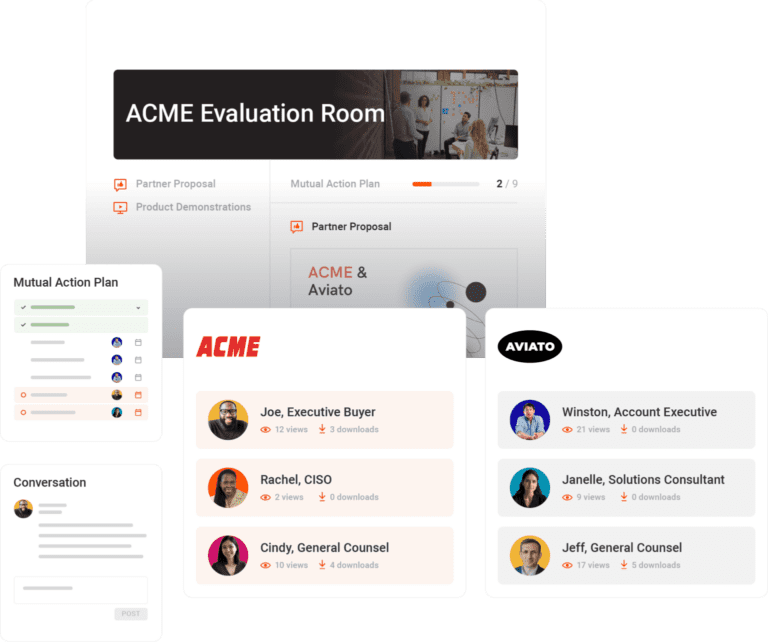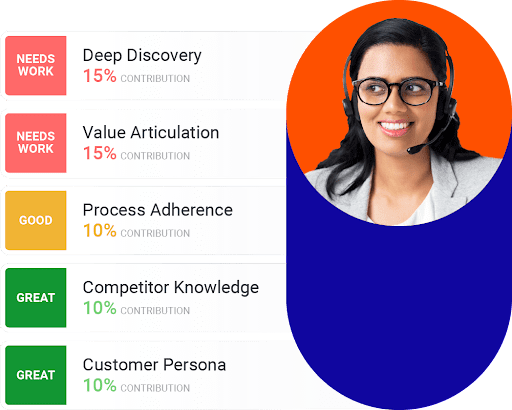While CROs and sales leaders can’t name every single tool in their tech stack, they do know one thing.
They have too many.
Research shows that 41% of organizations have 10-15 tools in their tech stacks– and another 18% with 16-20 tools – but it’s not leading to better quota attainment. Bloated tech stacks are leading to organizational (and data) silos and an urgency to consolidate.
In this blog, we’re here to help you understand:
- Benefits of consolidating your sales tech stack
- What types of technologies to consolidate
- Top use cases for consolidation
- Questions to ask yourself before consolidating
- DOs and DON’Ts of consolidating successfully
Benefits of consolidating your sales tech stack
There are many benefits of consolidating your sales tech stack.
Reps are trained faster
Reps often feel the biggest benefits. Our customers who have consolidated with Mindtickle say their reps are trained 40-50% faster and improve their overall sales efficiency.
While reps in organizations with siloed tech stacks spend just 30% of their time actually selling, with consolidation, reps know what tools to use each day, and spend less time looking for content. They are also better able to work each stage of the sales cycle and match content and next steps to what that particular buyer needs.
Managers can coach more people at scale
Prior to consolidating its sales tech stack, one Mindtickle customer could count on a manager to oversee 4-5 people. After consolidating and improving the scalability of coaching and deal reviews, this same manager can successfully coach 8-9.
Reduced time and administration
Anyone who has ever participated in getting a sales technology off of the ground knows how time-consuming it is to:
- Get to know the new tool
- Implement it
- Customize and support it
- Drive usage and adoption
- Continue justifying the investment and proving its ROI
Working with too many sales tech vendors spreads teams thin, and makes it difficult for those organizations to partner together to truly help you drive a sales transformation. Rather than focusing on streamlining workflows, reducing clicks, and driving revenue goals, your time gets sucked up being courted by dozens of vendors who are often primarily thinking about how to keep their seat at the table in this precarious economy. That is not productive for you.
Reduced compliance and security risks
A goal of any good cybersecurity and compliance strategy is to reduce the sales tech stack. Why? Because every new vendor you add opens up risk. Not only do you need to onboard and offboard employees constantly, but there is another team of people with access to critical documents about your strategy and products. As much as possible, it is best practice to focus on fewer trustworthy partners who follow best-in-class compliance protocols.
Create a culture of collaboration
When teams start to use too many different sales technologies, they inevitably adopt different sources of truth and workflows. This can lead to big discrepancies between how people think about business performance, people performance, and what to do each day. In the world of revenue tech, RevOps might work in one platform and see issues with the forecast or pipeline that don’t properly get communicated to enablement.
Enablement might be looking at sales engagement and program statistics that show their efforts are paying off, but have little to no idea that a specific person, team, or sales stage is suffering so they can target and personalize their efforts.
Managers and reps might be completely misaligned on what deal risks even exist, how responsive prospects actually are, and the activity volumes that take place each day.
And CROs, who are responsible for reporting to the board, often get stuck finding problems, but not actually providing the team with strategic guidance on how to go beyond and fix those problems.
As much as possible, building a single data model for the sales org gets the whole revenue team aligned.
Positively impact cash flow and spend
Here at Mindtickle, we know that the average 40-person selling team consolidating its tech stack saves $150,000 annually. For enterprise organizations, the potential financial benefits are much, much steeper.
While cost does not mean you have to sacrifice quality and results, it should not go unmentioned that organizations that do streamline their sales tech stack and eliminate redundant sales technologies reap big savings.
Tech consolidation is key to revenue productivity
Now that we know why organizations are consolidating their sales tech stacks, and why so many are urgently doing it now, what use cases exist? What types of technologies are they even consolidating?
There are many, but the biggest trend in consolidation right now is in connecting sales enablement and sales operations solutions with the goal of helping reps work and win more deals consistently and at scale. Another good way of putting this is that revenue orgs today are focused on helping reps know what to say, show, and do to win every sales stage.
At Mindtickle and other organizations, these new consolidated platforms are often referred to as revenue productivity platforms. The big idea behind revenue productivity platforms is that they not only help you identify people, deals, and teams that need your attention but actually drive change management at scale.
In a nutshell, revenue productivity platforms help you uncover insights on what deals, teams, and people need your attention but also go beyond to fix them with built-in enablement.
Here are some of the top use cases to consider when consolidating.
With a unified user experience, it’s much easier for reps to find the content that best wins deals without much thinking.
By connecting your content and sales training programs to revenue operations Platforms that do things like help you uncover issues with your forecast, pipeline, and quota attainment, organizations are also able to create more relevant, ROI-driven content and training programs.
At the same time, by empowering revenue teams to work in a platform where they can not only launch programs but deep-dive specific deals and calls, they are able to better root their programs in real field evidence.
Dead are the days when enablement teams would launch a program and cross their fingers that reps actually adopted it in the field. With a consolidated tech stack, the whole team works as one. It’s much easier to hold reps accountable for using the messaging and doing the activities you’ve prescribed as part of your new sales process or sales methodology. In fact, most organizations that consolidate their tech stacks are able to significantly scale deals and call reviews.
With a unified tech stack, not only can you decode what top reps do differently to win more, but you can also drive scalability and repeatability by rolling out things like templates and sales plays.
One of the top use cases is to encourage reps to build Digital Sales Rooms for customers and work deals diligently using Mutual Action Plans.

Better performance benchmarking and analysis of key sales outcomes
With a consolidated sales tech stack, organizations can start to get really clear about what their Ideal Rep Profiles and competencies look like. This means that instead of relying on manually input CRM data to predict who will hit quota or not, organizations can start to define the skills, activities, and in-field behaviors that make reps successful or not.


Once those Ideal Rep profiles and competencies are defined, organizations can better benchmark who is ready or not to hit quota. At Mindtickle, we call this the Sales Readiness Index. Dozens of our customers use it to know which teams and people need their attention.
This level of benchmarking is only possible when you unify your sales tech stack and begin to create a single data model around all of your buyer and seller interactions, as well as your sales competencies.
A culture of practice, reinforcement, and coaching
Sales coaching is essential, and it’s proven to drive bottom-line results. In fact, companies that provide quality coaching can reach 7% greater annual revenue growth. But why do so many fail to go beyond the one-way training provided through a typical Learning Management System?
A siloed sales tech stack is often the culprit.
By unifying your sales tech stack, you can enlist sales managers to participate a whole lot more. Finally, you can deliver insights like these to sales managers:
- Deal health score
- Deal risk insights
- Visibility into calls, emails, and meetings
- Visibility into buyer engagement
- Adoption of sales processes and methodologies, such as MEDDPIC
Once sales managers can access this data in one place, they can prescribe training programs that content reps should check out.
At the same time, features like AI video role-plays and reinforcements help reps overcome the forgetting curve by helping them practice and retain knowledge.
Questions to ask yourself before consolidating
Now that you know why businesses are consolidating redundant sales technologies and the use cases they are pursuing, here are some questions to ask yourself.
- When it comes to my current tech stack, what needs and pain points does my team have?
- Where are we paying for redundant features?
- What tools are driving the most/least usage for us?
- What tools are creating silos and misalignment between different departments?
- Which of our vendor relationships are the most efficient and successful? Which ones are lacking or taking up too much of our time?
- Are our sales tech costs where they need to be?
- Do the sales technologies we use integrate nicely?
Ready to see the magic of consolidating your revenue tech stack into a single platform?
Now that the benefits of consolidating your tech stack are clear and you’ve asked yourself if it makes sense for your organization, you might be ready to evaluate a single-platform solution. If that’s the case, here are some dos and dont’s that will serve as a valuable guide when choosing a technology partner:
Take inventory of your existing sales tools and evaluate their effectiveness, usage, and integration capabilities.
Clearly outline your goals and desired outcomes for consolidating your sales tech stack. Identify the specific functionalities and features you need to support your sales process.
Look for tools that seamlessly integrate with your existing systems, such as CRM, marketing automation, or customer support software. Smooth data flow and automation are crucial for a consolidated tech stack.
Seek input from your sales team throughout the consolidation process. Consider their needs, pain points, and preferences to ensure the new stack aligns with their workflows and enhances their productivity.
Select tools that can accommodate your business’s growth and evolving needs. Scalability is essential to avoid the need for frequent changes and migrations in the future.
Opt for intuitive tools that require minimal training and onboarding. User adoption plays a significant role in the success of your consolidated tech stack.
Prioritize the security of your sales data when selecting tools. Verify that the vendors have robust security measures in place, including data encryption, access controls, and compliance with relevant regulations like GDPR.
Plan for proper training and ongoing support to ensure a smooth transition and user adoption. Neglecting training can hamper your team’s ability to effectively utilize the consolidated tech stack.
While consolidating your tech stack can bring efficiency and cost savings, carefully evaluate the total cost of ownership, including licensing fees, implementation costs, and any potential hidden expenses.
Anticipate your future requirements and select tools that can adapt and grow with your business. Avoid short-term solutions that may become obsolete or inadequate as your sales operations expand.
Ready to learn more about how to consolidate your sales tech stack? Get in touch with our team so we can talk through your challenges and understand how a consolidated tech stack will help your sellers be more productive.
Consolidate your sales tech stack with Mindtickle
Talk with an expert about your current tech stack and how Mindtickle combines all your revenue productivity solutions and data into one tool.
Get a DemoThis post was originally published in January 2022, updated in May 2023, and again in March 2024.







